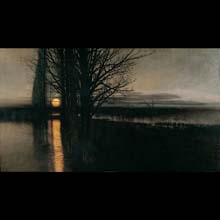
material: oil on canvas
dimensions: 124 × 220 cm
description: This nocturne depicts an area of water illuminated by the flickering reflection of the moon, visible between the dark silhouettes of trees. It was inspired by a poem by Juliusz Słowacki entitled "Beniowski". In this work, the poet several times describes a pond in the gardens of the Ladawa castle in a truly impressionistic way, observing the changeability of the surface of the water depending on the weather and the time of the day. Masłowski probably illustrated an excerpt from Canto I, in which Beniowski, looking “at the house of his lover,” sees “a pensive oak [...] wedded to a poplar” and the moon which “has risen to cast a blood-red glow over the Ladawa pond.” Nonetheless, the painter has shown in more detail the luminous/colour effect connected with the fading out of the glow of the sun and the deepening of darkness as well as the infiltration of moonlight in the air, on the ground and on the water in the form of reflections and varied saturation of tones. Masłowski’s work – perhaps the best one in his oeuvre – is an example of mood painting, known as stimmung. Besides the inspiration by the poem and the works of Munich painters, one can also see some similarity to the paintings by Claude Monet: Sunset (1872) and Impression, Sunrise (1874). Wacława Milewska
exposition: The Gallery of 19th Century Polish Art in Sukiennice,
The Cloth Hall, 1, Main Market Square
key: Realism, polish impressionism, beginnings of symbolism >>>
dimensions: 124 × 220 cm
description: This nocturne depicts an area of water illuminated by the flickering reflection of the moon, visible between the dark silhouettes of trees. It was inspired by a poem by Juliusz Słowacki entitled "Beniowski". In this work, the poet several times describes a pond in the gardens of the Ladawa castle in a truly impressionistic way, observing the changeability of the surface of the water depending on the weather and the time of the day. Masłowski probably illustrated an excerpt from Canto I, in which Beniowski, looking “at the house of his lover,” sees “a pensive oak [...] wedded to a poplar” and the moon which “has risen to cast a blood-red glow over the Ladawa pond.” Nonetheless, the painter has shown in more detail the luminous/colour effect connected with the fading out of the glow of the sun and the deepening of darkness as well as the infiltration of moonlight in the air, on the ground and on the water in the form of reflections and varied saturation of tones. Masłowski’s work – perhaps the best one in his oeuvre – is an example of mood painting, known as stimmung. Besides the inspiration by the poem and the works of Munich painters, one can also see some similarity to the paintings by Claude Monet: Sunset (1872) and Impression, Sunrise (1874). Wacława Milewska
exposition: The Gallery of 19th Century Polish Art in Sukiennice,
The Cloth Hall, 1, Main Market Square
key: Realism, polish impressionism, beginnings of symbolism >>>












